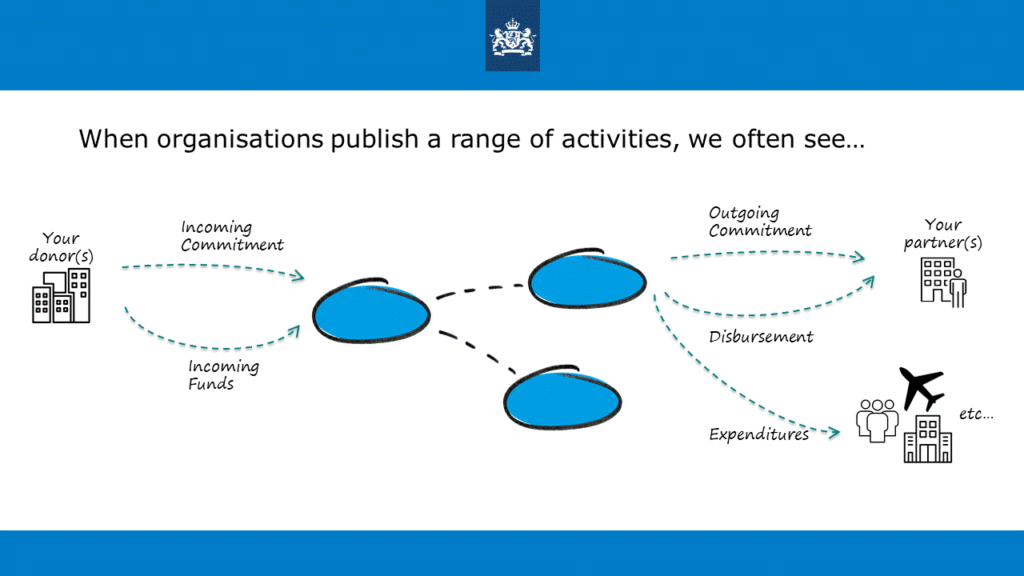Financial transactions in IATI
In IATI, you can use transactions to show the funds that flow in and out of an activity. IATI knows several types of transactions. NL MFA usually looks at 5 of these types.
Using these transactions, you can show:
- What is agreed: when you sign a contract with a donor or another funder, that is an incoming commitment. When you sign a contract with an implementing partner, that’s an outgoing commitment.
- Actual cash flows: when you receive an installment (paid by the donor), that is an incoming funds transaction. When you transfer funds to your implementing partner, that is a disbursement.
- And of course, you will spend money for running your activity: those can be staff costs, housing, travel, services etc. Expenditures, in IATI terms. If you don’t have an implementing partner because you implement the activity yourself, all of your outgoing money is expenditures.

What information is expected for each of these transactions?
For Incoming transactions – incoming commitment and incoming funds:
- Transaction type: 1 (incoming funds) or 11 (incoming commitment)
- Transaction date
- Transaction value (+ value date)
- Who is the provider, as much information as possible*:
- Name: the name of the organisation
- Ref: provider organisation identifier
- Provider-activity-id: the activity id of the provider (in our case XM-DAC-7-PPR-400…etc.)
* The provider information is especially important, because this information is used to gain insight in the chain of activities you are a part of. Please provide as much information as is possible. If a provider does not publish IATI data, identifiers cannot be provided.
For outgoing transactions – outgoing commitments and disbursements:
- Transaction type: 2(outgoing commitment) or 3 (disbursement)
- Transaction date
- Transaction value (+ value date)
- Who is the receiver*:
- Name: the name of the organisation
- Ref: receiver organisation identifier
- Receiver-activity-id: often, ‘downstream’ activity nrs are not known (yet).
* If a receiver does not publish IATI data, or has not defined activities yet, identifiers can not be provided
For expenditures:
- Transaction type: 4
- Transaction date
- Transaction value (+ value date)
- Expenditures may be aggregated per period – please follow your own administration or reporting periods. Then the transaction date is the last day of the aggregation period.
Please note:
- It is also possible to add sector, country, classifications etc. per transaction. You don’t need to add these because NL MFA only uses this info at the activity level!
- Only point ‘one level up, one level down’: if you work in an consortium, and you got the funding via the lead, please refer to the lead organisation as your funder (who in turn will be funded by the back donor).
- Sometimes we see that the expenditures or other outgoing transactions mentions the donor as the provider. This is incorrect: the funding may have originally come from your donor, but that’s only relevant for the incoming funds and incoming commitments. If it’s leaving your activity, you are the provider. If it’s coming in (from the perspective of your activity), your donor is the provider.
What if you have multiple activities?
When organisations publish a range of activities, we often see:
- Incoming transactions at the parent level
- Outgoing transactions at the child level
- Of course, you may also have expenditures (or other outgoing transactions) at the parent level: just show what happens. “Publish what you do”.

Internal ‘transactions’:
Inside an organisation, in general there are no real (bank) transactions. In order to still be able to see the relative contributions of different funders, we ask you to show internal budget allocations as incoming commitments at the child level.
Doing so, this model also allows for showing multiple sources of funding – e.g. co-funding by a different donor – at any level of activity.

